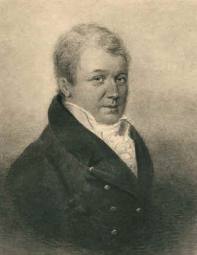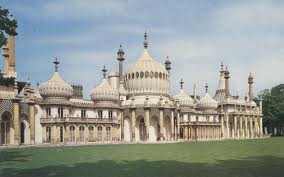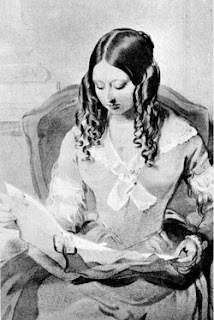Perhaps the most famous set of false teeth are the ivory set once worn by George Washington, pictured at left. Ivory dentures were popular into the 18th century, and were made from natural materials including walrus, elephant or hippopotamus ivory. These ill fitting and uncomfortable ivory dentures were replaced by porcelain dentures, introduced in the 1790’s, which weren’t much more successful due to their brightness and tendency to crack. In fact, the most favored material for false teeth was . . . . real teeth.
Presiding at the annual meeting of the British Dental Association held in Dublin in 1888, Mr. Daniel Corbett, Dental Surgeon, stated : “Six weeks was the usual time spent in the manufacture of a complete denture when working bone and natural teeth. When human teeth were in fashion, our supply was usually had from the graveyard, and I recollect what attention was paid to the gravedigger at his periodical visits to my father’s residence with his gleanings from the coffins he chanced to expose in the discharge of his avocation. His visits were generally at night, and no hospitable duty in which my father might chance to be engaged was permitted to interfere with the reception of this ever welcome visitor into the sanctum sanctorum of the house.The gravediggers every Monday morning made their way to the dental depots, each with his sack on his back containing the ghastly burdens collected during the previous week . . . we can scarcely realize the horror of the scene of these men bringing the jaws which they had turned up in “God’s acre” in their daily avocation; but mankind required teeth, and to meet the need most of those put in the mouth came from the jaws of the dead.”
 While graveyards were a profitable source for cadever teeth, the quantity of teeth typically on hand was limited. Enter the Peninsular Wars and the Battle of Waterloo. Of the 50,000 men who fell at the Battle of Waterloo, most were young and healthy and their teeth were of a generally good standard, much better than the teeth employed in the majority of dentures. Having been plundered from the battlefield, most of these teeth made their way back to Britain, the country best placed to afford the new top-quality dentures which would incorporate them. These then became known as ‘Waterloo Teeth,’ a set of which are pictured at right. The name quickly established itself as applying to any set of dentures made from young and healthy teeth taken from a Napoleonic battlefield and continued as a term on into the 19th Century.
While graveyards were a profitable source for cadever teeth, the quantity of teeth typically on hand was limited. Enter the Peninsular Wars and the Battle of Waterloo. Of the 50,000 men who fell at the Battle of Waterloo, most were young and healthy and their teeth were of a generally good standard, much better than the teeth employed in the majority of dentures. Having been plundered from the battlefield, most of these teeth made their way back to Britain, the country best placed to afford the new top-quality dentures which would incorporate them. These then became known as ‘Waterloo Teeth,’ a set of which are pictured at right. The name quickly established itself as applying to any set of dentures made from young and healthy teeth taken from a Napoleonic battlefield and continued as a term on into the 19th Century.
The Quarterly Review 1842 refers to a portion of Bransby Cooper’s biography of his uncle, surgeon Sir Astley Cooper, and runs – “Tooth hunters followed the armies, moving in as soon as the living had left the field. `Only let there be a battle and there will be no want of teeth; I’ll draw them as fast as the men are knocked down,’ says one such hunter in The Life of Astley Cooper. There were so many spare teeth that they were shipped abroad by the barrel. In 1819, American dentist Levi Spear Parmly, the inventor of floss, wrote that he had `in his possession thousands of teeth extracted from bodies of all ages that have fallen in battle.’
“This seems always to have been a regular though subordinate pursuit with them even at home. One of our author’s acquaintances, Mr. Murphy, robbed the vault under a London meeting-house, in one night, of teeth which he sold for 60 pounds. No wonder, then, if We find in a subsequent page that one of these fellows returned from Waterloo with a box of teeth and jaw-bones valued at 100 pounds. Did the autumnal beauties of 1816 suspect this? But the most precious harvest of all was, we are told, that of 1813. ‘ The German universities,’ says a French dentist, ‘turned out many youths in their very bloom; and our conscripts were so young that few of their teeth had been injured by the stain of tobacco.’ The Polish Jews were very active at this work during Napoleon’s later campaigns; and we remember a British dentist who was nicknamed Dr. Pulltuski from the notoriety of his dealings with them.”
On a more humorous note, it’s interesting that at least two books, Modern England 1820-1885 By Oscar Browning and Sir Spencer Walpole’s History of England both refer to George IV’s false teeth. It seems that the King was set to deliver a speech to Parliament in February of 1825, but had lost his false teeth and so it was delivered, instead, by Lord Eldon.
Separate mineral teeth, designed to be mounted on gold or other plates, which finally gave the death blow to the use of the gleanings of the graveyard, were the invention of a M. Audibran, of Paris, and were introduced into England by Mr. Corbett and their manufacture was taken up by Mr. Claudius Ash, of London, in 1837, who rapidly wrought a marvellous improvement in their strength and beauty, and severed once and for all the gravediggers’ connection with the dental surgery. In America, the Civil War continued to provide a source for human teeth.
The following ad appeared in The Solicitor’s Journal and Reporter of June 4 1859
MOSELY, SURGEON-DENTIST, Sole Inventor And Patentee.
A new, original, and invaluable invention, consisting in the adaptation, with the most absolute perfection and success, of CHEMICALLY-PREPARED WHITE and GUM-COLOURED INDIA-RUBBER, as a lining to the gold or bone frame. The extraordinary results of this application may be briefly noted in a few of their most prominent features:—All sharp edges are avoided; no spring wires or fastenings are required; a greatly increased freedom ot snction is supplied ; a natural elasticity, hitherto wholly unattainable, and a fit,perfected with the must unerring accuracy, arc secured; while from the softness and flexibility of the agent employed, the greatest support is given to the adjoining teeth when loose or rendered tender by the absorption of the gums. The acids of the mouth exert no agency on the chemically-prepared India-rubber, and, as it is a non-conductor, fluids of any temperature may be retained in the mouth, all unpleasantness of smell and taste being it the same time wholly provided against by the peculiar nature of its preparation.
The introduction of anaesthesia had a dramatic effect on dentistry. Along with ether and chloroform, nitrous oxide became the most preferred option and most surgeries were equipped with general anaesthetic equipment by the end of the 19th century. Many people were now prepared to have their rotting teeth extracted, which led to an enormous demand for cheap and efficient dentures. The introduction of vulcanite in the mid 19th century meant that dentures could be mass-produced and became affordable, replacing the expensive ivory versions. However, old false teeth apparently still had some value as we read in Methods and Machinery of Practical Banking by Claudius Buchanan Patten (1908) – It is asserted that in these days of poor teeth the average adult has at least a dollar’s worth of gold in his mouth, and that, consequently, every generation buries in the cemeteries of the United States 950,000,000 in gold. It may be that in England more economy is shown than here in the disposition of dental deposits, for I have seen in London stores any quantity of old false teeth on sale for the gold that was fixed in them. In the London `Times’ it is very common to see a long list of advertisements of second-hand clothing and secondhand false teeth for sale.
The 20th century saw an explosion of new materials, techniques and technology in dentistry. Novocaine was introduced early in the 1900’s as a local anaesthetic by a German chemist, Alfred Einhorn. The use of local anaesthetics during dental procedures did much to change the public’s attitude towards dentistry. By 1907 the British School Dental Service opened the first UK children’s clinic. Toothbrush clubs operated in London schools, and toothbrushes were issued to all serving men during World War I, which extended their use into working class families for the first time.
Originally published June 2010












